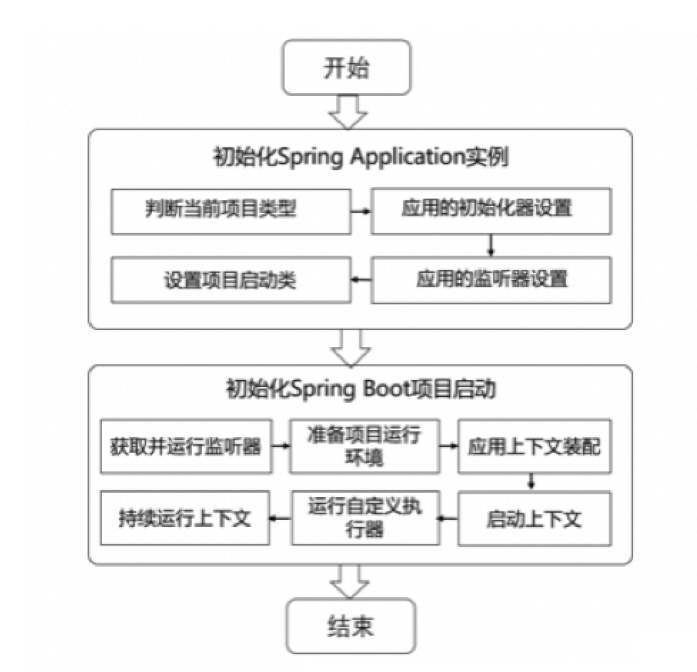您好,登錄后才能下訂單哦!
您好,登錄后才能下訂單哦!
今天小編給大家分享一下SpringBoot執行過程實例分析的相關知識點,內容詳細,邏輯清晰,相信大部分人都還太了解這方面的知識,所以分享這篇文章給大家參考一下,希望大家閱讀完這篇文章后有所收獲,下面我們一起來了解一下吧。
每個Spring Boot項目都有一個主程序啟動類,在主程序啟動類中有一個啟動項目的main()方法,在該方法中通過執行SpringApplication.run()即可啟動整個Spring Boot程序。
問題:那么SpringApplication.run()方法到底是如何做到啟動Spring Boot項目的呢?
下面我們查看run()方法內部的源碼,核心代碼具體如下:
@SpringBootApplication
public class SpringbootDemoApplication {
public static void main(String[] args) {
SpringApplication.run(SpringbootDemoApplication.class, args);
}
}public static ConfigurableApplicationContext run(Class<?> primarySource, String... args) {
return run(new Class[]{primarySource}, args);
}
public static ConfigurableApplicationContext run(Class<?>[] primarySources, String[] args) {
return (new SpringApplication(primarySources)).run(args);
}從上述源碼可以看出,SpringApplication.run()方法內部執行了兩個操作,分別是SpringApplication實例的初始化創建和調用run()啟動項目,這兩個階段的實現具體說明如下
查看SpringApplication實例對象初始化創建的源碼信息,核心代碼具體如下
public SpringApplication(ResourceLoader resourceLoader, Class... primarySources) {
this.sources = new LinkedHashSet();
this.bannerMode = Mode.CONSOLE;
this.logStartupInfo = true;
this.addCommandLineProperties = true;
this.addConversionService = true;
this.headless = true;
this.registerShutdownHook = true;
this.additionalProfiles = new HashSet();
this.isCustomEnvironment = false;
this.resourceLoader = resourceLoader;
Assert.notNull(primarySources, "PrimarySources must not be null");
// 把項目啟動類.class設置為屬性存儲起來
this.primarySources = new LinkedHashSet(Arrays.asList(primarySources));
// 判斷當前webApplicationType應用的類型
this.webApplicationType = WebApplicationType.deduceFromClasspath();
// 設置初始化器(Initializer),最后會調用這些初始化器
this.setInitializers(this.getSpringFactoriesInstances(ApplicationContextInitializer.class));
// 設置監聽器(Listener)
this.setListeners(this.getSpringFactoriesInstances(ApplicationListener.class));
// 用于推斷并設置項目main()方法啟動的主程序啟動類
this.mainApplicationClass = this.deduceMainApplicationClass();從上述源碼可以看出,SpringApplication的初始化過程主要包括4部分,具體說明如下。
(1)this.webApplicationType = WebApplicationType.deduceFromClasspath()
用于判斷當前webApplicationType應用的類型。deduceFromClasspath()方法用于查看Classpath類路徑下是否存在某個特征類,從而判斷當前webApplicationType類型是SERVLET應用(Spring 5之前的傳統MVC應用)還是REACTIVE應用(Spring 5開始出現的WebFlux交互式應用)
(2)this.setInitializers(this.getSpringFactoriesInstances(ApplicationContextInitializer.class))
用于SpringApplication應用的初始化器設置。在初始化器設置過程中,會使用Spring類加載器SpringFactoriesLoader從META-INF/spring.factories類路徑下的META-INF下的spring.factores文件中獲取所有可用的應用初始化器類ApplicationContextInitializer。
(3)this.setListeners(this.getSpringFactoriesInstances(ApplicationListener.class))
用于SpringApplication應用的監聽器設置。監聽器設置的過程與上一步初始化器設置的過程基本一樣,也是使用SpringFactoriesLoader從META-INF/spring.factories類路徑下的META-INF下的spring.factores文件中獲取所有可用的監聽器類ApplicationListener。
(4)this.mainApplicationClass = this.deduceMainApplicationClass()
用于推斷并設置項目main()方法啟動的主程序啟動類
分析完(new SpringApplication(primarySources)).run(args)源碼前一部分SpringApplication實例對象的初始化創建后,查看run(args)方法執行的項目初始化啟動過程,核心代碼具體如下:
public ConfigurableApplicationContext run(String... args) {
StopWatch stopWatch = new StopWatch();
stopWatch.start();
ConfigurableApplicationContext context = null;
Collection<SpringBootExceptionReporter> exceptionReporters = new ArrayList();
this.configureHeadlessProperty();
// 第一步:獲取并啟動監聽器
SpringApplicationRunListeners listeners = this.getRunListeners(args);
listeners.starting();
Collection exceptionReporters;
try {
ApplicationArguments applicationArguments = new DefaultApplicationArguments(args);
// 第二步:根據SpringApplicationRunListeners以及參數來準備環境
ConfigurableEnvironment environment = this.prepareEnvironment(listeners, applicationArguments);
this.configureIgnoreBeanInfo(environment);
// 準備Banner打印器 - 就是啟動Spring Boot的時候打印在console上的ASCII藝術字體
Banner printedBanner = this.printBanner(environment);
// 第三步:創建Spring容器
context = this.createApplicationContext();
exceptionReporters = this.getSpringFactoriesInstances(SpringBootExceptionReporter.class, new Class[]{ConfigurableApplicationContext.class}, new Object[]{context});
// 第四步:Spring容器前置處理
this.prepareContext(context, environment, listeners, applicationArguments, printedBanner);
// 第五步:刷新容器
this.refreshContext(context);
// 第六步:Spring容器后置處理
this.afterRefresh(context, applicationArguments);
stopWatch.stop();
if (this.logStartupInfo) {
(new StartupInfoLogger(this.mainApplicationClass)).logStarted(this.getApplicationLog(), stopWatch);
}
// 第七步:發出結束執行的事件
listeners.started(context);
// 返回容器
this.callRunners(context, applicationArguments);
} catch (Throwable var10) {
this.handleRunFailure(context, var10, exceptionReporters, listeners);
throw new IllegalStateException(var10);
}
try {
listeners.running(context);
return context;
} catch (Throwable var9) {
this.handleRunFailure(context, var9, exceptionReporters, (SpringApplicationRunListeners) null);
throw new IllegalStateException(var9);
}
}從上述源碼可以看出,項目初始化啟動過程大致包括以下部分:
第一步:獲取并啟動監聽器
this.getRunListeners(args)和listeners.starting()方法主要用于獲取SpringApplication實例初始化過程中初始化的SpringApplicationRunListener監聽器并運行。
第二步:根據SpringApplicationRunListeners以及參數來準備環境
this.prepareEnvironment(listeners, applicationArguments)方法主要用于對項目運行環境進行預設置,同時通過this.configureIgnoreBeanInfo(environment)方法排除一些不需要的運行環境
第三步:創建Spring容器
根據webApplicationType進行判斷, 確定容器類型,如果該類型為SERVLET類型,會通過反射裝載對應的字節碼,也就是AnnotationConfigServletWebServerApplicationContext,接著使用之前初始化設置的context(應用上下文環境)、environment(項目運行環境)、listeners(運行監聽器)、applicationArguments(項目參數)和printedBanner(項目圖標信息)進行應用上下文的組裝配置,并刷新配置
第四步:Spring容器前置處理
這一步主要是在容器刷新之前的準備動作。設置容器環境,包括各種變量等等,其中包含一個非常關鍵的操作:將啟動類注入容器,為后續開啟自動化配置奠定基礎
第五步:刷新容器
開啟刷新spring容器,通過refresh方法對整個IOC容器的初始化(包括bean資源的定位,解析,注冊等等),同時向JVM運行時注冊一個關機鉤子,在JVM關機時會關閉這個上下文,除非當時它已經關閉
第六步:Spring容器后置處理
擴展接口,設計模式中的模板方法,默認為空實現。如果有自定義需求,可以重寫該方法。比如打印一些啟動結束log,或者一些其它后置處理。
第七步:發出結束執行的事件
獲取EventPublishingRunListener監聽器,并執行其started方法,并且將創建的Spring容器傳進去了,創建一個ApplicationStartedEvent事件,并執行ConfigurableApplicationContext 的
publishEvent方法,也就是說這里是在Spring容器中發布事件,并不是在SpringApplication中發布事件,和前面的starting是不同的,前面的starting是直接向SpringApplication中的監聽器發布啟動事件。
第八步:執行Runners
用于調用項目中自定義的執行器XxxRunner類,使得在項目啟動完成后立即執行一些特定程序。其中,Spring Boot提供的執行器接口有ApplicationRunner 和CommandLineRunner兩種,在使用時只需要自定義一個執行器類實現其中一個接口并重寫對應的run()方法接口,然后Spring Boot項目啟動后會立即執行這些特定程序
下面,通過一個Spring Boot執行流程圖,讓大家更清晰的知道Spring Boot的整體執行流程和主要啟動階段:

以上就是“SpringBoot執行過程實例分析”這篇文章的所有內容,感謝各位的閱讀!相信大家閱讀完這篇文章都有很大的收獲,小編每天都會為大家更新不同的知識,如果還想學習更多的知識,請關注億速云行業資訊頻道。
免責聲明:本站發布的內容(圖片、視頻和文字)以原創、轉載和分享為主,文章觀點不代表本網站立場,如果涉及侵權請聯系站長郵箱:is@yisu.com進行舉報,并提供相關證據,一經查實,將立刻刪除涉嫌侵權內容。